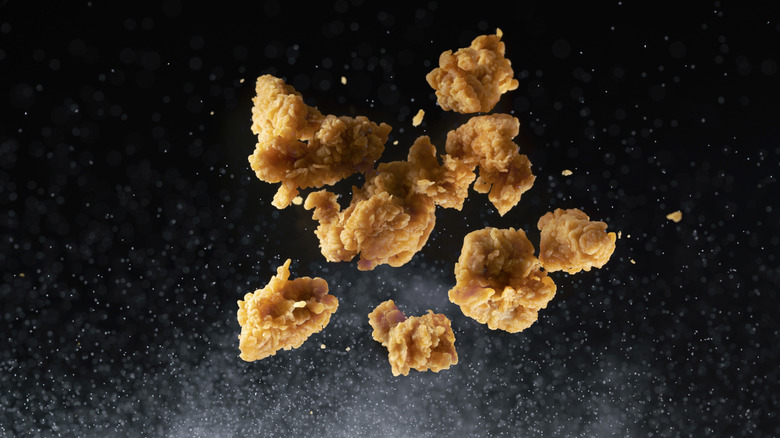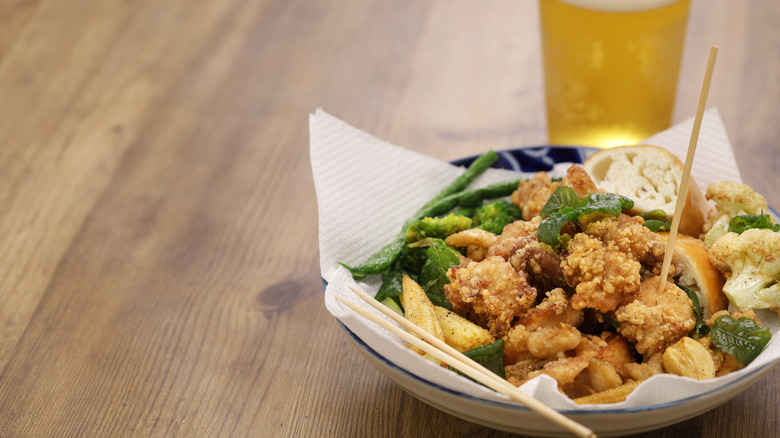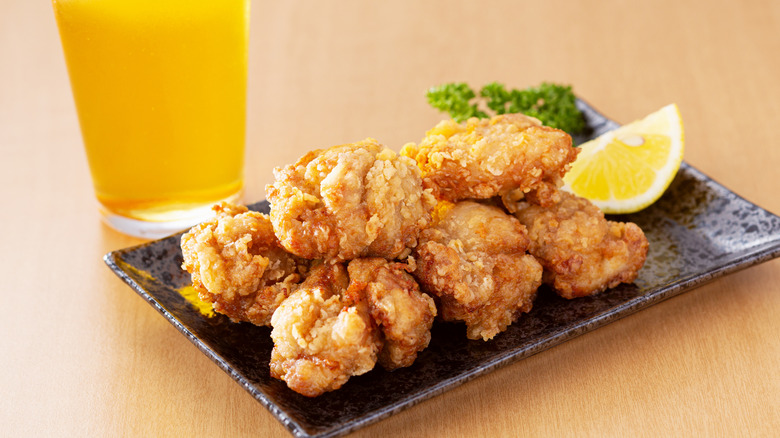Taiwanese Popcorn Chicken Vs Karaage: What Makes These Crispy Fried Bites So Wildly Different?
Popcorn chicken isn't just a popular bite in the U.S., but it's also a smash hit across other cultural cuisines, like in Taiwan and Japan. Both Taiwanese popcorn chicken and karaage are, as you might have guessed, predominately made with chicken — though one of the two wasn't always. These two tasty dishes share a delightful crispiness. However, how they get that result varies from the marinades to the coatings.
Taiwanese popcorn chicken is a staple in night market food scenes across Taiwan. Served hot, crispy, and bursting with flavor, passersby can enjoy this dish in little paper bags with wooden skewers for utensils as an excellent snack while enjoying all the night market has to offer. This dish is rumored to have originally been the country's answer to KFC-inspired chicken nuggets.
The history behind Japan's version of fried chicken, karaage, didn't actually originate on the island nation, and it wasn't chicken that was first used. The dish was first introduced to Japan by the Chinese during the Tang dynasty, with tofu as the choice of protein. As the dish gained popularity, it evolved to use a variety of seafood like finfish, crab, and octopus. After the U.S. soldiers introduced the broiler chicken to Japan over the course of World War II, karaage made with chicken took off as a means to combat the food scarcity the country had suffered.
Taiwan's popcorn chicken is bursting with spice
Rather than using the double dredge method for fried chicken, Taiwanese popcorn chicken is marinated in a mixture of rice wine, spices, sometimes a small amount of wheat flour, and baking powder. Prior to going in the fryer, it's then coated with sweet potato starch, which is what provides that signature crunch. The use of sweet potato starch gives the dish a delicately, delicious crisp that keeps you coming back for more. Coarse sweet potato starch will work best to get the quintessential crispiness with the little air pockets.
Outside of its secret to a perfectly light and crispy exterior, the magic of Taiwanese popcorn chicken lies in its depth of flavor and spices crucial to making a dish worthy of a Taipei night market. Elements like fried basil leaves for garnish, as well as a dusting of white pepper for a more subtle secondary spice level, offer a unique appeal that's hard to match. Then there's the rice wine in the marinade as well as the five-spice powder, all crucial to the dish.
Another important element is the type of chicken used. Opting for dark meat like chicken thighs instead of chicken breasts will mitigate dryness, keeping your popcorn chicken as equally juicy as it is crispy. Next time you're enjoying Taiwanese popcorn chicken, pair the spicy, crispy bites of goodness with a Champagne or sparkling wine that's on the sweeter side. It's a laid-back yet lush combo you'll totally want to experience. Plus, sweet and spicy is a flavor match made in heaven.
Karaage's many iterations
The main components of karaage today come down to the choice of marinade and the flour or starch mixture the protein is dusted in. Like with Taiwan's popcorn chicken, karaage also isn't dredged in a batter; instead, it is dusted in either flour, some type of vegetable starch, or a combination thereof. For the marinade, there are two competing flavors and techniques that dominate the preparations of karaage: shio (salt) or shoyu (soy sauce). The shoyu method will give you a stronger umami flavor from the soy sauce while the shio method uses salt to enhance the natural flavor of the chicken. Adding sake to the shio-based marinade will help add some of that umami flavor as well as provide some acidity — similar to soaking in buttermilk in U.S. fried chicken.
For the coating, some of the best karaages will be made with a blend of potato (or corn) starch and wheat or rice flour. The myriad street-food stalls and storefronts in Japan will use any of these or make their own blend: The possibilities are numerous and delicious. Using a 50/50 blend of wheat flour and rice flour will give you light and juicy bites while wheat flour and potato starch give you the best of both fried chicken worlds.



